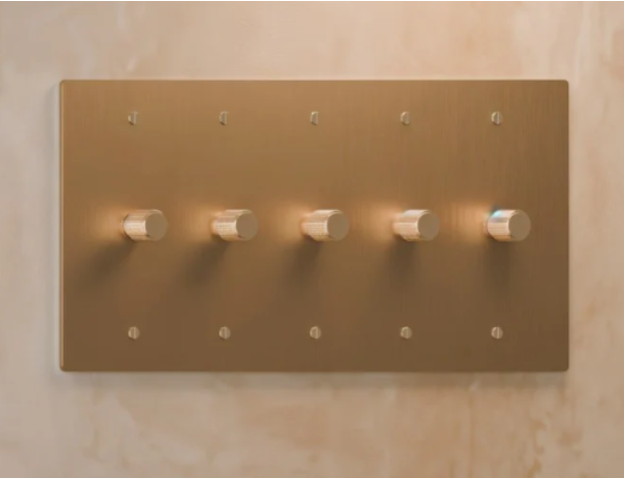How to Wire a Light Switch?

The standard single-pole light switches are the types that turn a light on and off by moving the toggle or paddle on the switch up or down. This familiar switch is actually called a single-pole light switch by hardware dealers and electricians.
The side of a single-pole switch has two brass terminal screws that connect to the black hot wire in the electrical circuit. One black wire comes from the power source electrical panel and the other wire goes to one or more light fixtures.
When the switch is on, electricity flows from the inbound wire to the outbound wire through the switch. When you turn off the switch, the flow of electricity stops.
Think of it like a drawbridge that allows cars to cross when in place, but impedes the flow of cars when open. Most switches also have a green ground screw that connects to the circuit’s ground wire to safely ground the switch.
Here is a step by step guide to wiring a Light Switch:
Please Note: You’ll need a professional electrical insulating screwdriver set, a new light switch, wire strippers, and electrical tape. If you have the tools, you’ll need to complete the task during daylight hours because it will turn off the electricity in your home.
Turn off the electric switch
Before you begin, you must disconnect the light switch to ensure you are not working on an active circuit. Find the fuse box with the large on/off switch and slide it to turn it off. As an extra safety precaution, you can remove the fuse that controls the lighting circuit you are working on.
Now test to see if the electricity is turned off. Test the switch you are replacing and any other connected electrical appliances, such as lamps or TVs, to make sure they are not working.
Remove existing switch
Carefully remove the switch plate using a suitable screwdriver. Place the screw in a safe place so you don’t lose it. Now see which wire goes where. Take a photo for reference.
Typically, a one-way switch has two terminals: COM on the top and L1 on the bottom. The brown live feed wire connects to the COM terminal and the blue switch wire, wire connects to the L1 terminal. The blue switch wire, wire usually has a brown sleeve or tape indicating that it is an active circuit and not a neutral circuit, as its color suggests.
For the previous wiring, this would be the red live feed wire going into the top COM terminal and the black (switch wire) wire going into the L1 terminal. Again, the black (switch wire) wire usually has red tape or sleeve on it to indicate that it is an active circuit and not neutral.
Connect the new switch
Loosen the terminal screws holding the wires in place, carefully pull the wires out, and set the old light switch aside. Make sure the ends of the wire are neatly twisted and the wire is not tangled. Use pliers to clean it up if necessary.
You may need to strip the wires with a pair of wire strippers and trim them with a pair of pliers. Leave about 15 mm of bare wire and enough length to make wiring the new terminal easier. Insert the brown or red live feed wire into the COM terminal and tighten.
Pull gently to make sure it is securely fastened. Do the same with the switch blue or black wire and place it on the L1 terminal. If the cable does not fill the terminal, you can strip the wire further back and fold it over to ensure a secure connection.
If you are installing a light switch with a metal faceplate, you will need to connect the green/yellow ground wire to the faceplate. Once completed, slide the cables into the backbox and screw the switch plate back on to ensure it is secure. Finally, restore power to test the new switch.
Frequently Asked Questions
What are the new wiring colors?
The current standard wiring colors of green/yellow, blue and brown were introduced in 2004 and from early 2006 all new wiring installations have been required to adopt these colors.
However, if you live in a home built before the code went into effect, the wiring is likely red, black, or green/yellow (before 1977, the earth was green).
The old live red wire was replaced with brown, the old neutral black wire with blue, and the old green ground wire with yellow and green.
Anytime you do household electrical work, including wiring light switches or plugs, it’s important to note the colors and make sure you’re connecting to the correct terminals.
What do L1 and L2 mean on a light switch?
Unidirectional switches typically have a COM or COMMON terminal on the top and an L1 terminal on the bottom. A two-way switch adds an L2 terminal next to the L1 terminal.
Replacing a light switch may be a good time to replace a light fixture since you already have the necessary tools and the power is off.
Are the switch markings on all light switches the same?
No. Different manufacturers may have slightly different markings on the inside of their switches. A typical one-way switch has a COM or COMMON marking next to the top terminal of the switch and an L1 marking next to the bottom terminal of the switch.
A typical two-way switch that can be used as a one-way switch has an additional terminal labeled L2 next to L1. However, it is worth noting that some manufacturers do not use COM marking and instead mark the upper terminal as L1 and the lower terminals as L2 and L3.
Should I ground my plastic drywall backbox?
When installing a light switch, the back box is usually recessed into the wall. These are typically metal or plastic and what material is used will determine whether grounding is required.
Always connect the grounding conductor to metal light switches and light fixtures. When in doubt, always contact a competent, qualified electrician.





